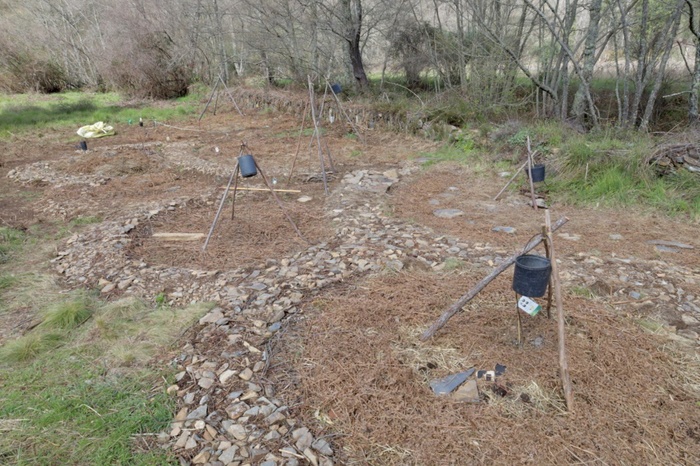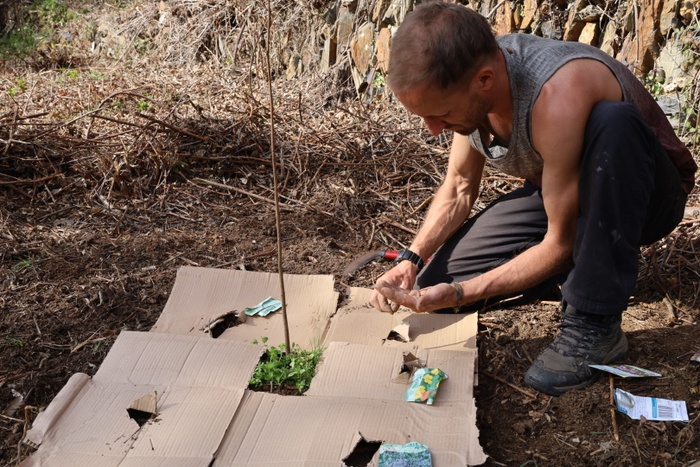If you were to ask a Taoist monk when is the best time to plant a tree?, the monk would likely answer "twenty years ago or now."
The local elders tell us that the lower terrace site what we now call Tão Valley used to be farmed for annual grains. It was always a lot of work, they said, but they had fun doing it.
Indeed, it's always a lot of work to get food production started. But what if you could plant everything needed to grow food once, and then the work needed to maintain food production reduces as the whole system of plantings mature?
This is one of the differences between mainstream agriculture and a permaculture based food production design. It's based on perennial plants that live for a long time, producing a yield year after year once established. A popular design feature of a permaculture project is a food forest. And this is what we have now started to create at Tao Valley!
To begin our food forest, we've been shaping a series of water-harvesting basins linked by a flowing network of raised pathways. The intention is to capture and store energy by channelling rainwater into the basins where the plants can soak it up and hopefully reduce our need for irrigation or manual watering.
At the centre of every basin is a tree with a family of companion plants around it - ground layer plants, climbers and shrubs. Some fix nitrogen, others attract insects, provide shade or help to protect the tree from fungal disease.
We're planting a whole host of fruiting and non-fruit deciduous trees in this way. Apple, cherry, chestnut, fig, pear, peach and plum to name a few varieties that we've started with. It's a timely effort to hitch a ride (and reduce our workload) on Nature's rainy season.
Every element of this food forest design performs several functions to create a diverse network of collaboration and resilience between plants, fungi and wildlife.
It will be exciting to see these 'tree guilds' grow to their potential. As we've chosen plants that blossom and fruit at different times of the year so that we can encourage the honey bees to settle here, as well as prolong the harvest for our food longer.
How easy it is to rush in doing things and start making changes when one has something new to do, especially as a 'doing' kind of person. Observe and interact is perhaps the first principle of permaculture put into action and guides us to simply sit and watch all the intricate dances and plays of the environment around us. I've done this for a year now and, in that time, what's come to me is a grand vision for this land and how we can live on it.
Yet, describing things in words has never been my strong point. Indeed, trying to describe my vision in words wasn't really helping the people around me imagine what I had in mind and so, this week I put pencil to paper and let the creativity flow.
I've been envisioning a project of this kind for many years and now I'm so grateful that I can actually apply it to my own space. This is what transpired on the paper.
It was great fun drawing this Where's Wally-esque (Waldo for any non-brits reading this!) pictorial of how I see the project in ten years time. At the center is our superadobe house complete with a rooftop terrace and greenhouse on the south side of the building. There's the food forest on the terrace below with a diverse mix of fruiting trees and plants designed to provide an opportunity to harvest food all year round. Up the top of the hill is Shambhala, our auditorium for yoga practice and other events. Immediately below that there's something called a keyline dam, a type of water-harvesting earthwork that holds water further uphill allowing it to slowly infiltrate the subsoil and providing hydration to the trees further downhill. Off to the left of the land is a whole area dedicated to reforestation, promoting an abundance of wildlife habitat. It's crucial that we fulfil every opportunity to link each element of this design with the next so that everything benefits from a diversity of inter-connectedness.
To get from where we are now to this, clearly, there's a huge amount of work to be done. I realise that beginning with the end in mind, as coached by Stephen Covey in his book 7 Principles of Effective Behaviour, helps to set about a chain of actions that eventually lead to that end. Being mindful of not being attached to it, this particular end would be a dream come true!


